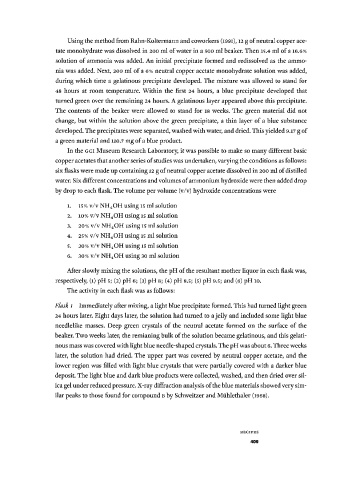Page 426 - Copper and Bronze in Art: Corrosion, Colorants, Getty Museum Conservation, By David Scott
P. 426
Using the method from Rahn-Koltermann and coworkers (i99i), 12 g of neutral copper ace
tate monohydrate was dissolved in 200 ml of water in a 500 ml beaker. Then 15.4 ml of a 16.6%
solution of ammonia was added. An initial precipitate formed and redissolved as the ammo
nia was added. Next, 200 ml of a 6% neutral copper acetate monohydrate solution was added,
during which time a gelatinous precipitate developed. The mixture was allowed to stand for
48 hours at room temperature. Within the first 24 hours, a blue precipitate developed that
turned green over the remaining 24 hours. A gelatinous layer appeared above this precipitate.
i
The contents of the beaker were allowed to stand for s weeks. The green material did not
change, but within the solution above the green precipitate, a thin layer of a blue substance
developed. The precipitates were separated, washed with water, and dried. This yielded 9.17 g of
a green material and 110.7 mg of a blue product.
In the GCI Museum Research Laboratory, it was possible to make so many different basic
copper acetates that another series of studies was undertaken, varying the conditions as follows:
six flasks were made up containing 12 g of neutral copper acetate dissolved in 200 ml of distilled
water. Six different concentrations and volumes of ammonium hydroxide were then added drop
by drop to each flask. The volume per volume (v/v) hydroxide concentrations were
1. 15% v/v NH 4 OH using 15 ml solution
2. 10% v/v NH 4 OH using 15 ml solution
3. 20% v/v NH 4 OH using 15 ml solution
4. 25% v/v NH 4 OH using 15 ml solution
5. 30% v/v NH 4 OH using 15 ml solution
6. 30% v/v NH 4 OH using 30 ml solution
After slowly mixing the solutions, the pH of the resultant mother liquor in each flask was,
respectively, (1) pH 5; (2) pH 6; (3) pH 8; (4) pH 8.5; (5) pH 9.5; and (β) pH 10.
The activity in each flask was as follows:
Flask 1 Immediately after mixing, a light blue precipitate formed. This had turned light green
24 hours later. Eight days later, the solution had turned to a jelly and included some light blue
needlelike masses. Deep green crystals of the neutral acetate formed on the surface of the
beaker. Two weeks later, the remianing bulk of the solution became gelatinous, and this gelati
nous mass was covered with light blue needle-shaped crystals. The pH was about 6. Three weeks
later, the solution had dried. The upper part was covered by neutral copper acetate, and the
lower region was filled with light blue crystals that were partially covered with a darker blue
deposit. The light blue and dark blue products were collected, washed, and then dried over sil
ica gel under reduced pressure. X-ray diffraction analysis of the blue materials showed very sim
ilar peaks to those found for compound Β by Schweitzer and Mühlethaler (i968).
R E C I P E S
409

